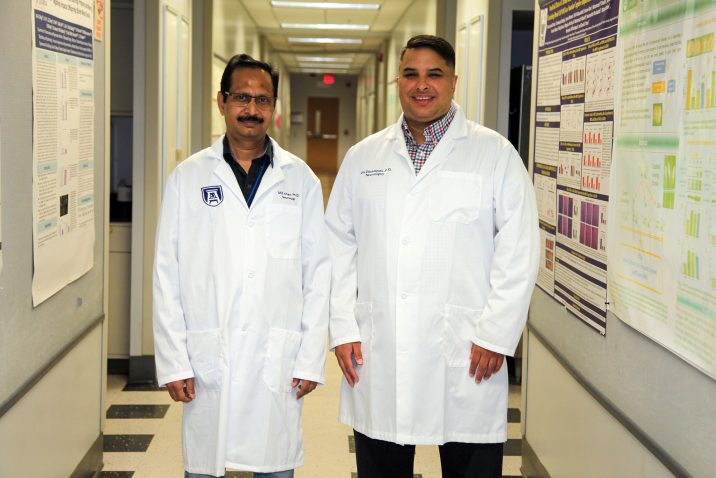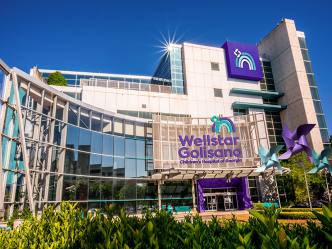Scientists want to know more about how an inexpensive, low-risk treatment may improve recovery from the most deadly type of stroke.
The treatment, remote ischemic conditioning, or RIC, involves successive bouts of compressing then relaxing an arm or leg with a blood pressure-like cuff, most typically for four cycles of five minutes of inflation followed by five minutes of deflation.
The most deadly stroke is an intracerebral hemorrhage, the most common form of hemorrhagic stroke, in which blood, which is toxic to brain tissue, spills out of blood vessels in the brain.
“When you look at this type of stroke on imaging you will have the blood there, taking up space, and then it just starts killing the tissue off within that area,” says Dr. Krishnan Dhandapani, neuroscientist in the Department of Neurosurgery at the Medical College of Georgia at Augusta University.
To aid recovery and survival, the spilled blood and already damaged brain tissue need to be promptly removed and new blood vessel networks laid down to properly restore blood and oxygen, as well as deliver healing trophic factors and nutrients to the damage site. The MCG scientists have laboratory evidence that RIC, already in clinical trials in several countries, helps.
Dhandapani is principal investigator on a new $1.9 million grant (RO1NS117565) from the National Institutes of Health that is enabling him and his colleagues to learn more about how RIC helps, and how long the treatment is needed to provide optimal benefit.
They have evidence that RIC enables better use of a natural pathway for brain repair, much as immunotherapy for cancer augments the body’s natural defense mechanisms.
“We are trying to accelerate functional recovery,” Dhandapani says. “RIC may just be hijacking the spontaneous mechanisms and making everything go faster.”
A consistent they have seen in their studies is improved blood flow to the brain and a shift toward an anti-inflammatory state, across not just hemorrhagic strokes, but the more common ischemic strokes, where a blood clot inside a blood vessel is the problem, and traumatic brain injuries as well.
In addition to location, all three have in common that while inflammation is important to healing early on, ongoing inflammation contributes to brain damage.
Potential theories about how RIC reduces damage include that the transient bouts of ischemia from compression of the arm or leg signal the brain, always the body’s first priority for blood and oxygen, that it needs to make adjustments. “It’s a controlled tourniquet really,” says Dhandapani. “But we don’t know the exact mechanism.”
Co-investigator and research scientist in the MCG Department of Neurology Dr. M.B. Khan says the benefits of RIC and exercise overlap, because exercise also increases the need for oxygen and activates factors that can help like the powerful blood vessel dilator nitric oxide. “This is a nonphysical mimetic of exercise,” adds Dhandapani. Like exercise, they say RIC may need to be continued to continue to see benefit.
Since RIC increases blood flow, the approach seemed counterintuitive at first in hemorrhagic stroke where it might increase bleeding, the scientists say. Instead: “It just opens the highway,” Dhandapani says of the resulting reparative shifts.
They suspect one way RIC improves blood flow is by creating shear stress as red blood cells are forced to squeeze through a narrower passageway. Shear stress is detected by the endothelial cells that line blood vessels which send paracrine signals, proteins synthesized by one cell that act on nearby cells to change their behavior, which in this case are telling neighboring smooth muscle cells inside the blood vessel wall to relax and let more blood through.
They have evidence RIC also prompts a shift away from the inflammatory environment needed right after injury, to an anti-inflammatory environ important to recovery. In fact, RIC’s impact does not appear to be immediate, rather after about the third day, clots start shrinking much faster in lab animals receiving RIC than in those who don’t, findings which Dhandapani and his colleagues have published. A key difference in the shift is the macrophages, a type of immune cell known for scarfing up debris, but that can also help turn inflammation both up or down. While macrophages keep cleaning after RIC, the scientists have found that they stop promoting inflammation, another of their published findings and a basis for some of the clinical trials of RIC now underway, Dhandapani says.
With this grant, they are further exploring these reparative macrophages to see what they are doing not just in the early days to help shrink the clot, but over six months, and whether, as they suspect, ongoing RIC is necessary to maintain whatever good they do. Khan has already conditioned a mouse model of dementia daily for six months and seen continued improvement. Now they are looking at both the timing for starting and continuing RIC for hemorrhagic stroke.
“We want to see if RIC kind of helps rebuild the brain,” Dhandapani says. “Is there anything that is reparative in the long term,” he says, which takes him back to opening the highway.
They have seen new blood vessel growth in aftermath of stroke and RIC in brain areas essentially wiped out by stroke, and think that the reparative macrophages may be helping with that longer term.
Now they are testing their hypothesis that the transient ischemia RIC induces in turn induces AMPKα1, a sensor and regulator of energy metabolism, and Del-1, a protein with an important role in blood vessel remodeling and development, to help restore the essential vascular network. They are doing things like knocking Del-1 out of mice to see if RIC’s benefit disappears along with the protein. If it does, they want to start measuring Del-1 levels in people using RIC to see if the protein’s level also increases in humans.
While RIC is not a “be all, end all,” it appears to help rebuild a viable infrastructure for viable brain tissue to once again exist in that area, with additional therapies down the road like stem cell therapy to regenerate neurons that will ultimately connect and restore networks and functions lost to stroke, Dhandapani says. “It’s a better microenvironment for regenerating neurons,” he says.
“You have to clear all the rubble if you want to build a new building. We think that is what macrophages are doing very early. We think step 2 is rebuilding the framework and structure,” he says.
RIC is one of a handful of potential new stroke therapies being compared in the National Institutes of Health initiative Stroke Preclinical Assessment Network, or SPAN, evaluating treatments with promise. Large studies using RIC in patients with stroke also are underway in Denmark and China and its being studied in dementia patients in Greece.
About 87% of strokes are ischemic where a blood clot impairs blood flow. With hemorrhagic strokes, typically a weak blood vessel inside the brain ruptures, which can form a large pool of blood, called a hematoma, in the brain tissue itself and blood, as well as the iron inside the red blood cells that carry oxygen, are highly lethal to brain tissue, especially the neurons or nerves, Dhandapani says. Additionally the hematoma can damage the brain by literally putting pressure on it, even shoving it aside if the hematoma gets big enough.
Chronic hypertension and plaque buildup inside blood vessels are major risk factors for hemorrhagic stroke. “These are patients who typically have chronic hypertension, so basically their blood vessels are under too much pressure chronically and that is what causes the initial rupture so you get bleeding inside the brain,” Dhandapani says.
Current therapies, which include surgery to remove the blood pool and studies to see if inserting clot-dissolving tPA, which is used successfully for ischemic strokes, into the blood pool can help eliminate the hematoma, are not super effective and surgery itself has associated risks, Dhandapani says. “I think the take home is we don’t have the answer yet for patients with intracerebral hemorrhage,” he says, but RIC may be part of it.
 Augusta University
Augusta University




